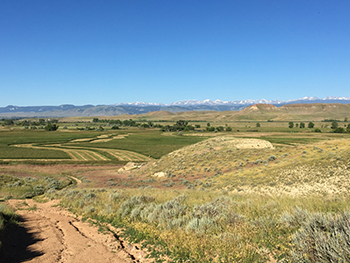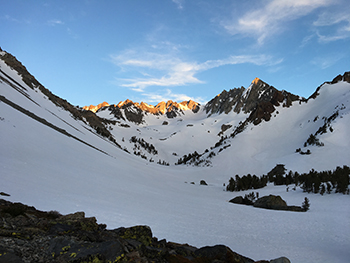This story is adapted from a University of Nevada, Reno release by Beatrice Gordon, originally found here.
Water often falls from the sky and is stored in mountains across the U.S. as snow before it melts and flows down to urban and rural communities. Knowing what factors influence when and how much of that snowmelt ultimately makes it to streams, rivers and reservoirs is crucial for water managers trying to make the most of limited water resources. A new study led by researchers at University of Nevada, Reno and the Desert Research Institute (DRI) published in Environmental Research Letters identifies three major factors that influence snowmelt-driven water supplies and identifies regions where mountain water supplies respond differently to climate change. The study used data from 537 watersheds across the U.S.
Relying on 30-plus years of previous research compiled over more than two years, the research found that three factors-how much of the total winter snowfall is available at the end of the winter, how fast snow melts and when snow melts-can be used to better predict how climate change will impact critical snowmelt-driven water supplies. And, the research team found major differences in how much each of these factors influences different watersheds throughout the country.
"In the best of times, water managers throughout Western North America have a challenging job of ensuring a reliable water supply to agricultural, urban and recreational users," said Paul Brooks, professor of geology and geophysics at the University of Utah. "They've done such a good job that many residents rarely give a second thought to their own water use. Increasingly, these managers are stuck between a rock and a hard place, as climate change and population growth are increasing water demand, while the amount and timing of water availability become more variable."
"Particularly in the Western U.S, snow is really the backbone of our water supply systems," said Beatrice Gordon, the lead author and a doctoral student in the University of Nevada, Reno Graduate Program of Hydrologic Sciences and the Department of Natural Resources & Environmental Science. "But what's challenging is that mountain water supplies respond differently to changes in snow depending on where you are in the U.S. Given that challenge, our goal was to provide other scientists and water managers with a simple, but powerful framework that can be used to improve predictions about the timing and amount of streamflow as climate change accelerates."
Taking inventory

Snow and glacial melt from the Wind River Mountains in Wyoming feeds the Wind River via Dinwoody Creek.
The first step in constructing this framework was to take inventory of what was known, and perhaps more importantly, what was not known, about how snow shapes streamflow. To do this, Brooks and researchers from University of Nevada, Reno and DRI teamed up with researchers at Boise State University and Universidad de Concepción in Chile to review over three decades of previous research. This review included over 150 studies about snow and streamflow from around the world. Based on this synthesis, they found that the amount of streamflow, and to a lesser extent when spring streamflow occurs, varies in response to changes in snow across the U.S.
"It seems like we should have very accurate systems to forecast mountain water supplies, but the dirty secret is that there is a lot of uncertainty caused by climate change and changes in snowpack," said researcher and co-author Adrian Harpold, associate professor at the University of Nevada, Reno. As part of the University's Experiment Station, the lab conducts field and remote sensing observations, as well as modeling, to help answer some of the most pressing questions related to mountain ecohydrology in the face of changing environmental conditions.
The lack of certainty around when and how much water will come from winter snowpacks is a serious issue for water managers tasked with meeting the needs of a growing population and increased demands for food. Particularly in the Western U.S., which is characterized by wetter winters and drier summers, the majority of surface water originates as snowfall in the mountains, with more than two-thirds of reservoir inflows coming from snow. For context, roughly 40 million people, and much of the most agriculturally productive land in the Western U.S., rely at least partially on snowmelt-derived streamflow stored in two of these reservoirs.

This hayfield in northeastern Wyoming depends on snowmelt from the Bighorn Mountains in the distance. Photo by Beatrice Gordon, University of Nevada, Reno.
A framework to navigate uncharted waters
The researchers' review highlighted the grand challenge of managing mountain water supplies given all the uncertainty and variability in regional responses to climate change. Drawing upon their literature review and decades of experience from senior researchers, the authors developed a simple framework, centered around three factors, designed to help water managers better navigate the challenges posed by a more complex and uncertain future.
- Snow season water vapor fluxes. Despite the complicated name, the function of this mechanism is straightforward. It controls how much snow is available at the end of winter. Throughout the winter, water stored in snowpacks is "lost" to the atmosphere via evaporation (when water turns into a gas) and via sublimation (when snow turns into a gas). As winters get warmer, these losses are likely to increase, which the research illustrates can reduce the amount of snow available to be released as streamflow.
- Intensity of liquid water inputs. This mechanism concerns how fast water from snowmelt and/or rain reaches the ground. The rate at which precipitation reaches the ground surface impacts where water ultimately goes. Warmer winters mean more intense winter rainfall, which the research shows can lead to more streamflow.
- Synchrony between water and energy inputs. This mechanism deals with when water from snowmelt and/or rain is available in relation to when we need it most. Unlike rain, snow stays on the ground after it falls, acting as a large temporary (and free) reservoir for cities and farms. Snowpacks have historically released water into streams in the late spring and early summer, when demand for water is higher. Less snow means less storage, which the research shows will increase the gap between when water is supplied and when it is most needed.
Using publicly available data from the 537 sites across the U.S., the researchers then used this framework to determine where each of these factors are most and least important. The relative importance of these mechanisms for mountain water supplies, which the authors summarize as "how much, how fast and when," vary geographically, based on the study's results.
Streamflow in the Great Basin, for example, is particularly sensitive to changes in all three of the mechanisms, making water management predictions an acute challenge in this region. However, nearby, on the other side of Donner Pass in the Sierra Nevada mountains, the research shows that how fast water reaches the ground surface and when water is available will be more important than how much snow is lost to the atmosphere via evaporation and sublimation.
More work to do
Complementing the USDA project, Brooks has been collaborating with the Salt Lake City Department of Public Utilities, Salt River Project, Weber Basin Water Conservancy District and other managers throughout the Western U.S. to identify and plan for changes in water supply in a warming climate.
The framework is only the first step toward answering big questions about the fate of water supplies for the team. Harpold and Gordon, along with Gabrielle Boisrame and Rosemary Carroll of DRI, are on a USDA-sponsored project, "SNOWPACs," led by the University of Nevada, Reno, in a collaboration with other universities.
"This study came out of a need to characterize variable changes in streamflow that are occurring in the Intermountain West and challenging reservoir management that are critical to agricultural water supplies," Harpold said.

Winter snowpack in the Sierra Nevada Mountains near Bridgeport, California, stores water to meet human, cultural, agricultural and environmental water demands in Nevada's Walker River Basin. Photo by Beatrice Gordon, University of Nevada, Reno.
The team is focusing its next efforts on understanding how these streamflow changes impact agriculturally dominated basins, including the Walker River Basin, which supplies water for agriculture in Nevada.
"As someone who grew up in agriculture in the Western U.S., I know how much snow matters to our farming and ranching communities," Gordon said. "And I'm excited to see how the work coming out of SNOWPACs provides critical information to decision-makers who are currently grappling with these changes in our mountain water supplies."
Support for the research recently published in Environmental Research Letters was provided the USDA NIFA (Project # NEVW-2017-08812) and the Lincoln Institute's Babbitt Dissertation Fellowship Program.






